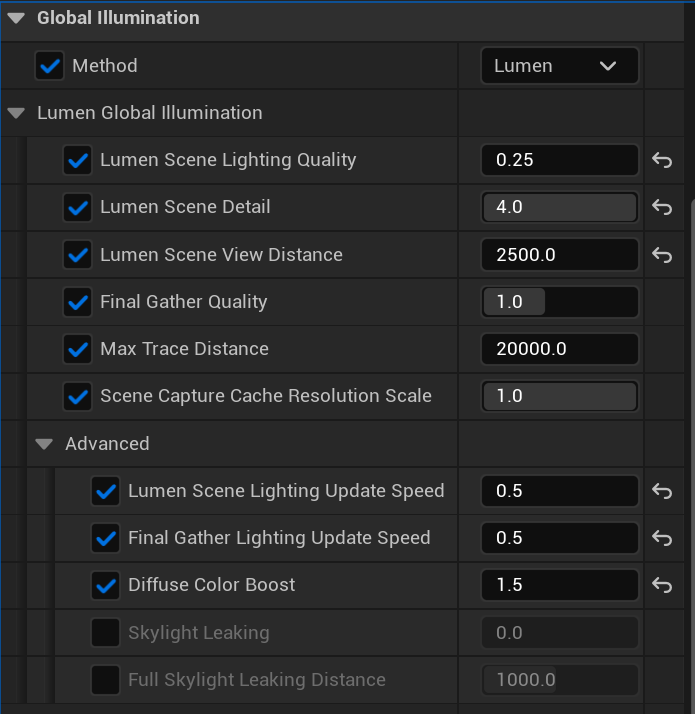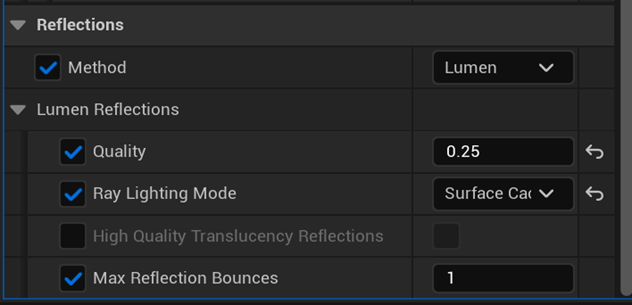Best Practices for hardware ray tracing with Lumen on Android Devices
Introduction
Lumen and Ray Tracing
Acceleration Structure
Only Add Important Objects into Ray Tracing
Take Full Advantage of Instancing
Optimize Acceleration Structure
Reduce Acceleration Structure Run-time Update Cost
Lumen General Setting Optimizations
Next Steps
Best Practices for hardware ray tracing with Lumen on Android Devices
We now look at how best to optimize with the Global Illumination settings. To use Lumen in your game scene, you can add a Post Process Volume actor (found under Place Actors > Visual Effects). Within the details panel of Post Process Volume, there are several options that you can change and amend. During the development of the Lumen content, “Steel Arms”, we found a few recommended values for these options that are suitable for Android devices. The following images show all of the option values that were used in “Steel Arms” with some additional explanation provided.
Global Illumination Settings
 Figure1. These global illumination parameters are used in our Lumen content - Steel Arms.
Figure1. These global illumination parameters are used in our Lumen content - Steel Arms.
Lumen Scene Detail
• Higher values ensure that smaller objects contribute to Lumen lighting but they do increase the GPU cost.
Final Gather Quality
• This controls the density of the screen probes but note that higher values will increase the GPU cost.
• 1.0 strikes a good balance between performance and quality for mobile games.
Max Trace Distance
• This controls how far the ray tracing will go; keeping the number small decreases the GPU cost.
• Do not set it to be larger than the size of the scene.
• Smaller values can also reduce ray incoherence.
Scene Capture Cache Resolution Scale
• This controls the surface cache resolution; smaller values save memory.
Lumen Scene Lighting Update Speed
• This can be kept low if lighting changes are slow to save GPU cost.
• 0.5 ~ 1.0 strikes a good balance between performance and quality for mobile games.
Final Gather Lighting Update Speed
• This can be kept low if slow lighting propagation is acceptable.
• 0.5 ~ 1.0 strikes a good balance between performance and quality for mobile games.
Lumen Reflection Settings
 Figure 2. These reflection parameters are used in our Lumen content - Steel Arms.
Figure 2. These reflection parameters are used in our Lumen content - Steel Arms.
Reflection Quality
• This controls the reflection tracing quality, essentially the resolution of the reflection.
Ray Lighting Mode
• The default (and recommended for mobile games) mode is Surface Cache, which reuses surface cache data for reflection.
• The Hit Lighting mode is available when using hardware ray tracing; it evaluates direct lighting instead of using the surface cache. It offers better quality but at a higher GPU cost and can also reflect the lighting of skinned meshes which Surface Cache mode cannot. Hit Lighting is not yet supported on mobile devices.
Max Reflection Bounces
• This controls the number of reflection bounces; higher values increase the GPU cost.
• 1 is recommended for mobile games.
This learning path has taken you through some key areas and best practices for using and optimizing hardware ray tracing with Lumen.